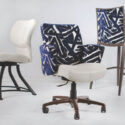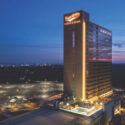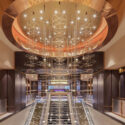
Gaming’s dilemma propels a lucrative era for the design world.
As casino operators crowd shrinking markets—Oklahoma alone sports about 100 properties—the need for separation intensifies. Special qualities become harder to demonstrate amid the constantly rising customer-demand bar.
Most casinos already display superb service, loyalty clubs and creative deal-structuring. Many add revenue-producing amenities like theaters and parking lots, or loss leaders like golf courses and spas, to keep customers on site. They seek a further edge by providing dinners, shows, rewards and discounts with the swipe of a card.
What is the next leg of in this customer-service race? And how does one stay on budget while looking cutting-edge?
Gaming looks to the hotel industry. Brand and boutique hotel concepts, the casino version of B&B, are much more than bed and breakfast.
In this emerging realm, casinos can be upscale yet subtle, personalized yet prosperous. More properties pin their separation hopes on hotel and convention space. They tap a resource once geared toward wealthy business travelers.
This philosophy originated in the 1980s. A classic boutique hotel meant themes and services in a stylish, intimate manner. As technology emerged, guest rooms became fitted with Wi-Fi internet, honesty bars, on-site dining facilities, bars and restaurants. This concept became popular in major cities, and targeted road warriors. Hence, the rise of Starwood and W Hotels.
It also attracted gaming interests, which brought a branding element into play. Branding denotes name recognition, as in Hard Rock. A certain service standard and amenities list surrounds a well-known property.
Branding and boutique. Both avenues are available to casinos, but dollars must be spent wisely.
This is where designers make a difference. They have large staffs and a presence in multimillion-dollar buildings, but can also stretch the expansion-project dollar. They can maximize space, select appropriate colors, utilize local artifacts and blend the right dash of history into a modern look. Their clients can swagger, even on a “shoestring” budget.
And that’s never been more important.
Find What’s Special
Tom Hoskens, principal and director of strategic design for Cuningham Group in Minneapolis, Minnesota, likes the roles boutique and branding play in the hotel-casino business.
“They are going together more and more,” Hoskens indicates. “The boutique hotel set out the parameters. It’s all about the service amenities, about making it unique. The boutique hotel takes the branded experience as a promise that you are going to have a certain type of experience time and again. It can be a great bar, terrific restaurant or a special spot for people to congregate.
“Gaming has taken that and said that no matter what size property you have, you can have that special experience, and it can be wonderful, especially if you can take advantage of your location.”
Cuningham’s influence on the Harrah’s Cherokee property in North Carolina bears out Hoskens’ point. His company won awards for its massive and tasteful $650 million renovation, which won a host of HOSPY Awards. They include the best buffet and best theatrical experience for 2012 and best lobby and suites for 2011.
While a property’s overall beauty is impressive, Hoskens believes it works by sparking human emotion. In his eye, every building tells a story, and one’s imagination can be unleashed within that context.
“Harrah’s has that great Smokey Mountains influence,” he says. “It has the rock and the stone. It has the wood. It has the twigs, the dappled light, all in the space of the lobby itself, and the rooms carry through.
“You have this brand promise for Harrah’s that says ‘I am in a special place.’ The hotel casino skyway is across a creek where people are fishing for trout. It is a special branded experience and that can only happen in this one place in this one time.”
Cuningham applies the concept of exclusivity differently with Bossier City, Louisiana’s Margaritaville. The property opened in July with a heavy design emphasis, naturally, on Jimmy Buffett, the performer for whom it is named.
“It’s a little bit about the cheeseburger, but mostly about the paradise,” Hoskens jokes, linking Buffett’s famed “Cheese-burger in Paradise” tune to the property’s branded message. The hotel projects a flamboyant party air onto its gaming premises.
“From the hotel lobby, you are going through a bit of forest,” Hoskens says. “You are traveling through a green area and as you are going through this special place with plants, flowers and trees, what do you see in the distance but a Tiki bar? And that is just before you get to the room. This is a specialty experience, a boutique experience, and you know that this guy is coming back.”
Hoskens says smaller operators can obtain bang for their buck with precise planning about multi-use of space and a streamlined effort between construction and design. In mid October, Cuningham won a contract for the Valley River casino to be built about an hour away from Harrah’s Cherokee. Its budget is smaller than Margaritaville, but Hoskens believes it will maximize the dollars. Hoskens says his group and the construction company work closely together. This figures to produce a coordinated spending approach, with design ideas being implemented in the most cost-effective fashion.
“This will be 300 rooms, and is going to have a specialty boutique look and feel to it,” Hoskens says. “This ought to be interesting. We are just starting the project now. The Valley River actually exists in this area and is going to figure prominently in the design.”
Smaller properties need to hustle in unique ways. Hoskens says “they have to do something special in the room. All of them try to do that. Most of them play games with the bathroom and toilet room and the shower areas in an attempt to make a big impact. The second thing is, ‘How do you plug in your devices?’ What is your bed and sitting area like? How well do they work together? This is the low-hanging fruit, as it were.”
Cuningham has prospered with the rise of Indian gaming in the last quarter century.
Designing the Fun
Memphis-based Hnedak Bobo Group has a grip on large and small projects.
The company thinks big, but can fit those ideas into a smaller budget, if asked. Hnedak Bobo designed the Apache Casino Hotel, which opened in 2012, with that in mind. The Lawton, Oklahoma, property has been called “the most fun hotel from Oklahoma City to Dallas,” and is also one of the most luxurious lodging options in the southwest Oklahoma gaming market. And for a reasonable start-up cost.
“This $24 million hotel is a great example of a design that has enhanced and solidified the unique character of the Ft. Sill Apaches’ gaming brand,” says Dike Bacon, principal at HBG. “The hotel’s bold, bright colors and contemporary design aesthetic add to the high-energy gaming experience at the casino, and is giving its customers something to talk about through unique offerings that elevate the tribe’s brand.”
“Our guests often tell us how surprised they are by the quality and appealing design of our new hotel,” says Jeff Haozous, chairman of the Ft. Sill Apache Tribe of Oklahoma. “The attention to detail separates our property from any hotel in our region and provides an experience that, until now, was not available here. The hotel design complements and supports our overall gaming business.”
It’s hard to miss the new five-story, 132-key, 74,541-square-foot hotel, which is positioned to capture attention from patrons arriving from the west.
“The building’s vibrant contemporary exterior colors visually tie in with the existing casino and enhance the cohesiveness of the entire property,” says Nathan Peak, senior associate and lead designer at HBG.
At night, a vivid play of color and light act as a dazzling beacon for patrons.
“The hotel is designed to look and feel different at night,” Peak asserts. “Linear LED light coves were placed around the hotel roof edge, and the columns at the porte cochere were articulated with custom metal enclosures with LED pin lights that illuminate the columns from within. At night, there is no mistaking the instant drama that is created by this light display.”
A 25,171-square-foot promenade connector link provides creative casino and hotel separation, and serves a greater purpose than a mere passageway to and from the casino. The connector structure was created as the nucleus of the property, even functioning as the main entry lobby for hotel guests from a new two-lane porte cochere.
“Our guests feel like they are in a bigger city when they first enter the hotel lobby,” Haozous says.
HBG Interior Designer Jennifer Smith, along with Peak and Interior Architect Aron Ramage, worked closely with Haozous to achieve this effect.
“Our client really wanted to maximize playful, contemporary design, using vibrant patterns and fresh, clean lines,” says Smith.
Designers animated the connector walkway with colorful, modern feature walls and activated the location with key amenities. They include the main hotel check-in desk, business center and retail shop, a cozy lobby lounge with fireplace, and the new 360 restaurant featuring 126-seat dining, a 24-seat bar and a 22-seat private dining room. Topping it off is a 2,500-square-foot ballroom that partitions into smaller meeting rooms with a banquet-sized kitchen and an escalator to the mezzanine-level casino floor.
The five-story hotel offers a mix of standard rooms and suites. It totals 84 kings, 44 double queens and four suites, some with special features such as wet bars, large glass showers, and first-floor patios that lead to the swimming pool.
“All guestrooms and suites offer custom carpet and casework, with nice-sized bathrooms. We pulled high quality through all aspects of the public spaces and into the guestrooms,” Smith indicates.
“By working closely with the Ft. Sill Apache Tribe, we have created the ideal hotel design for a casino that is continuously noted for its charismatic customer service and friendliness,” says Janet Smith-Haltom, principal and project manager for HBG. “And as the Ft. Sill Apache Casino Hotel property grows, the design will accommodate graceful future expansion for additional amenities.”
Building on Relationships
Ken Kulas and Ann Fleming opened Las Vegas-based Cleo Design in 2000 and carved a steady niche in the design world.
Cleo has parlayed strong relations with tribal casinos into a long-running business plan. They constantly upgrade and expand the Seminole Hard Rock casinos in Tampa and Hollywood, Florida. The company has been part of the design and planning process since the properties opened.
What does the branded hotel mean in this era?
“The boutique concept gives you that step up in personal attention,” Kulas says. “You feel you will get more individual catering, a relationship with the concierge, etc. While a brand lets you know that you can have option A, B or C, the boutique idea attempts to do things on a much more personal level.”
Tribal and non-tribal properties are consistent with this approach. While they differ in one respect—Kulas says owners and operators are more influential in casino design than tribal officials—both entities need to know their product and audience.
“With the tribal projects, we find that many of the expansion projects they do are able to customize the different ideas to provide the guest a broader experience,” Kulas indicates. “This can be expressed in tower remodeling, and it can be reflected in the rooms with amenities like a return to themed experiences, which are becoming more popular. We had moved away from them, but they are coming back with rooms like the honeymoon suite or bachelor pad.
“Their approach is that you want to provide as many options as possible,” Kulas says. “Around Hard Rock Hollywood, for example, they have a lot of retired people in their area, so in that case the casino caters to one group during the daytime, primarily by way of specialty gaming events along with slots, bingos, raffles and giveaways. And then in the evening it takes on almost a club atmosphere with entertainment and special events. There are a few different things that come out at night. The lighting changes and the music gradually changes.”
The Hollywood property showcases a pool area, spa and great restaurants. Tower and hotel remodeling and gaming-floor expansion has been a continual process here.
In Tampa, the Seminoles have added a restaurant, pool bar and expanded gaming floor.
Cleo has also worked extensively with the Choctaw Nation in Durant, Oklahoma. Its most-recent 18-month project set to conclude late in 2014 spans a number of areas. The tribe is thinking both locally and regionally. Durant is only about an hour from Dallas, which expects to obtain gaming in the near future. So, it gears up.
“There is a lot of competition nearby and with Dallas,” Kulas asserts. “They want to stay ahead of the curve. They are trying to service the Dallas crowd, so they will keep coming. Their recent project is a convention and exhibit hall along with a new tower. Within that tower, the majority of the facility is set to cater to a convention type of person. Also mixed into this tower is a new spa facility. They have guest rooms specifically designed and oriented toward a spa customer. The finishes and amenities have a resort spa-type look.”
Kulas predicts an arsenal of four different products for the Choctaw operators. They will have both a Vegas and a local theme in a casino and hotel. Cleo is working on the exhibit hall and convention area for one casino, and the bowling alley and movie theater for the more locally based facility. Future plans included changes to the Choctaw Inn, which is tied in to the locals concept.
Whether for locals or tourists, branding to create boutique experiences is the element that has not only brought success to these projects, but is a key to success for designers working on projects with footprints that are dwarfed by the mega-resorts. In this case, smaller is better.

















